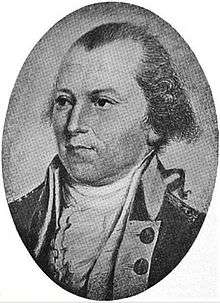William Malcolm

William Malcolm (January 23, 1745 – September 1, 1791) was a New York City merchant and officer in the American Revolution. He commanded Malcolm's Regiment, with Aaron Burr as his second in command.
Early life
William Malcolm was born in Glenrothes, Scotland on January 23, 1745. He moved to New York City while in his twenties and established himself as an import/export merchant. Malcolm grew wealthy, and as his influence increased he took part in politics and government, including serving as a member of the New York Assembly in 1774.[1]
Revolutionary War service
Malcolm was also active in the militia, and volunteered for military service during the American Revolution. He served in New York's military and the Continental Army throughout the Revolution, including assignments as Deputy Adjutant General of the Northern Department under Horatio Gates.[2]
In 1777 Malcolm was appointed to command a regiment. Called Malcolm's Additional Continental Regiment, he raised the organization and used his own funds to pay and equip it.[3] He commanded as Colonel, with Aaron Burr as second in command and Lieutenant Colonel, though Burr was often the de facto commander as the result of Malcolm's detached assignments as Deputy Adjutant General or for other duties.[4][5] Malcolm took part in the battles of Long Island, White Plains, Trenton and Princeton. He was with the Army during the 1777-1778 winter at Valley Forge, and he later commanded Continental forces in upstate New York.[6]
Near the end of the Revolution he was appointed commander of the militia in New York, Kings and Richmond Counties with the rank of Brigadier General.[7]
Post Revolutionary War
In 1785 he served on New York City's Board of Aldermen, and he served in the New York Provincial Congress in 1786 and 1787, where he advocated adoption of the United States Constitution.[8][9]
As head of the militia in and around New York City, Malcolm commanded George Washington's escort when Washington took the oath of office as the first President.[10]
Malcolm was a Freemason,[11] a member of the Saint Andrew's Society[12] and the Saint Nicholas Society,[13] and a founder of New York City's Chamber of Commerce.[14]
Death and burial
William Malcolm died in New York City on September 1, 1791. He was buried in Manhattan's Brick Presbyterian Church Cemetery.[15]
Family
Malcolm was married twice. His first wife was Abigail Tingley, whom he married in 1765, and who died in 1770. His second wife was Sarah Ayscough, whom he married in 1772.[16][17]
Malcolm's descendants included members of the prominent Bayard, Schuyler and Montgomery families.[18][19]
References
- ↑ Tuttle Company, The Tingley Family, 1910, page 31
- ↑ Henry Whittemore, The Heroes of the American Revolution and Their Descendants, 1897, page 15
- ↑ Nancy Isenberg, Fallen Founder: The Life of Aaron Burr, 2007, page 37
- ↑ Buckner F. Melton, Aaron Burr: The Rise and Fall of an American Politician, 2004, page 1910
- ↑ Nathan Schachner, Aaron Burr: A Biography, 1937, page 53
- ↑ Katharine Schuyler Baxter, A Godchild of Washington, 1897, pages 440 to 443
- ↑ Thomas Edward Vermilye Smith, The City of New York in the Year of Washington's Inauguration, 1789, 1889, page 66
- ↑ New York Assembly, Documents of the Assembly of the State of New York, Volume 33, 1913, page 697
- ↑ Oregon Society, Sons of the American Revolution Year Book, 1903, page 51
- ↑ Michael Brander, The Emigrant Scots, 1982, page 90
- ↑ William R. Denslow, Harry S. Truman, 10,000 Famous Freemasons, Volume 3, 2004, page 126
- ↑ George Austin Morrison, History of Saint Andrew's Society of the State of New York, 1756-1906, 1906, page 185
- ↑ Saint Nicholas Society of the City of New York, The History of the Saint Nicholas Society of the City of New York, Volume 1, 1905, page 235
- ↑ Gordon DenBoer, The Documentary History of the First Federal Elections: 1788-1790, 1987, page 457
- ↑ Henry Collins Brown, Valentine's Manual of Old New York, 1916, page 225
- ↑ Province of New York - Marriage Licenses prior to 1784, accessed December 4, 2012
- ↑ New York Genealogical and Biographical Record, Volumes 9-10, 1878, page 96
- ↑ Sons of the Revolution. New York Society, Year Book, 1893, page 365
- ↑ New England Historic Genealogical Register, The Weaver Family of New York City, Volume 47, 1893, page 53